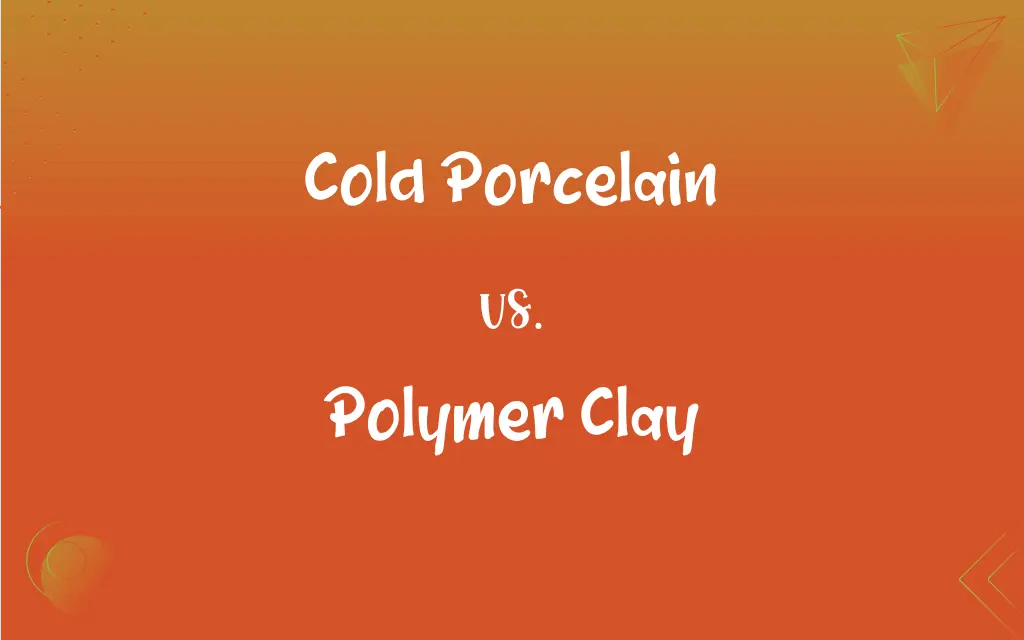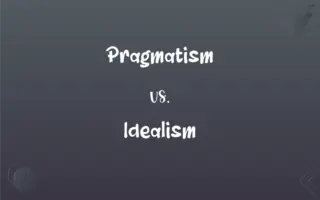Cold Porcelain vs. Polymer Clay: What's the Difference?
Edited by Harlon Moss || By Janet White || Published on December 31, 2023
Cold porcelain is an air-dry clay known for its fine, porcelain-like finish, whereas polymer clay is a bake-to-harden modeling material used for crafting and art.

Key Differences
Cold porcelain is a homemade or commercially available air-dry clay, known for its smooth, porcelain-like texture. Polymer clay, a PVC-based modeling clay, requires baking in an oven to harden, offering a durable and versatile medium for artists and hobbyists.
The flexibility of cold porcelain allows for intricate detailing, making it popular for delicate projects like flower making. Polymer clay, on the other hand, holds its shape well and is ideal for sculpting, bead-making, and mixed-media projects.
Cold porcelain can be made at home using simple ingredients like cornstarch and glue, making it a cost-effective option. Polymer clay is typically purchased and comes in a wide range of colors and finishes, including metallics and glow-in-the-dark.
Unlike polymer clay, cold porcelain tends to shrink slightly as it dries, which needs to be considered in precision work. Polymer clay remains the same size after baking, allowing for accurate sizing in projects like jewelry making.
Cold porcelain, once dried, can be painted or varnished, while polymer clay can be mixed with colors before baking, offering a different approach to color incorporation in creative projects.
ADVERTISEMENT
Comparison Chart
Composition
Air-dry clay made from cornstarch and glue
PVC-based clay requiring oven baking
Texture and Finish
Smooth, porcelain-like finish
Comes in various textures and finishes
Use and Flexibility
Ideal for delicate, fine work
Suitable for sculpting and mixed-media
Preparation
Can be homemade or bought
Commercially purchased in many colors
Post-Creation Process
Shrinks slightly, can be painted or varnished
Remains same size, colored pre-baking
ADVERTISEMENT
Cold Porcelain and Polymer Clay Definitions
Cold Porcelain
This clay is favored for its ability to be colored before or after drying.
Cold porcelain can be custom-tinted to create vibrant crafts.
Polymer Clay
Polymer clay remains soft until it is baked in a home oven, allowing for extended work time.
Polymer clay is ideal for projects that require time to sculpt intricate details.
Cold Porcelain
Cold porcelain dries to a hard, durable finish at room temperature.
Jewelry pieces made from cold porcelain are lightweight yet sturdy.
Polymer Clay
This clay is known for its durability and strength after baking.
Polymer clay figurines are long-lasting and resist breaking.
Cold Porcelain
Cold porcelain is a non-toxic, air-dry clay made from cornstarch and glue.
Artists use cold porcelain to create realistic flower models.
Polymer Clay
Polymer clay is used in professional and hobbyist art for its versatility.
From jewelry to miniature models, polymer clay's flexibility makes it suitable for various creative projects.
Cold Porcelain
It's known for its fine, smooth texture that emulates porcelain.
Cold porcelain is ideal for making intricate dollhouse miniatures.
Polymer Clay
Polymer clay is a type of modeling clay based on PVC that hardens when baked.
Polymer clay is popular for crafting colorful beads for jewelry.
Cold Porcelain
Cold porcelain is a versatile medium suitable for detailed craft projects.
Cold porcelain is often used for making delicate decorative items.
Polymer Clay
It's available in a variety of colors and can be mixed to create custom hues.
Artists blend different polymer clays to achieve unique shades for sculptures.
FAQs
How do you harden polymer clay?
Polymer clay hardens when baked in an oven at a specific temperature.
What is cold porcelain?
Cold porcelain is an air-dry clay known for its smooth, fine texture.
Can cold porcelain be baked?
No, cold porcelain hardens at room temperature and doesn't require baking.
Can cold porcelain be used for outdoor projects?
It's not recommended for outdoor use as it's not as durable as polymer clay.
What is polymer clay?
Polymer clay is a PVC-based modeling material that hardens when baked.
Can you mix colors with cold porcelain?
Yes, cold porcelain can be colored either before drying or painted afterward.
How long does cold porcelain take to dry?
It varies but typically takes 24 to 48 hours to dry completely.
What are the main uses of cold porcelain?
It's often used for fine crafts like flower making and miniatures.
What are the main uses of polymer clay?
Polymer clay is used for jewelry, sculptures, beads, and decorative items.
Is polymer clay suitable for children?
Yes, but it's advisable to supervise children due to the baking process.
Does polymer clay shrink when baked?
No, polymer clay maintains its size and shape when baked.
How do you finish cold porcelain items?
They can be sanded, painted, and varnished for a finished look.
Can you make polymer clay at home?
No, polymer clay is a commercial product and not typically homemade.
Are there any health risks with using cold porcelain?
Generally, no, as it is non-toxic, but it's advisable to avoid ingestion.
Can polymer clay be recycled?
Not in the traditional sense, but scraps can be reused in other projects.
How do you store unused polymer clay?
Store it in a cool, dark place, wrapped tightly to prevent drying out.
Is polymer clay environmentally friendly?
It is a plastic product, so considerations for environmental impact should be made.
Can cold porcelain be mixed with other materials?
Yes, it can be combined with materials like glitter or small beads for decorative effects.
Is cold porcelain waterproof?
Once varnished, it can be water-resistant but not entirely waterproof.
Can you paint on polymer clay?
Yes, polymer clay can be painted after baking.
About Author
Written by
Janet WhiteJanet White has been an esteemed writer and blogger for Difference Wiki. Holding a Master's degree in Science and Medical Journalism from the prestigious Boston University, she has consistently demonstrated her expertise and passion for her field. When she's not immersed in her work, Janet relishes her time exercising, delving into a good book, and cherishing moments with friends and family.
Edited by
Harlon MossHarlon is a seasoned quality moderator and accomplished content writer for Difference Wiki. An alumnus of the prestigious University of California, he earned his degree in Computer Science. Leveraging his academic background, Harlon brings a meticulous and informed perspective to his work, ensuring content accuracy and excellence.






































































